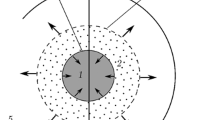Abstract
The entry of a shock wave from air into water containing reactive gas (stoichiometric acetylene–oxygen mixture) bubbles uniformly distributed over the volume of the liquid has been numerically investigated using equations describing two-phase compressible viscous reactive flow. It has been demonstrated that a steady-state supersonic self-sustaining reaction front with rapid and complete fuel burnout in the leading shock wave can propagate in this bubbly medium. This reaction front can be treated as a detonation-like front or “bubble detonation.” The calculated and measured velocities of the bubble detonation wave have been compared at initial gas volume fraction of 2 to 6%. The observed and calculated data are in satisfactory qualitative and quantitative agreement. The structure of the bubble detonation wave has been numerically studied. In this wave, the gas volume fraction behind the leading front is approximately 3–4 times higher than in the pressure wave that propagates in water with air bubbles when the other initial conditions are the same. The bubble detonation wave can form after the penetration of the shock wave to a small depth (~300 mm) into the column of the bubbly medium. The model suggested here can be used to find optimum conditions for maximizing the efficiency of momentum transfer from the pressure wave to the bubbly medium in promising hydrojet pulse detonation engines.
Similar content being viewed by others
References
S. M. Frolov, F. S. Frolov, V. S. Aksenov, and K. A. Avdeev, Request No. PCT/RU2013/001148 (2013). http://www.idgcenter.ru/patentPCT-RU2013-001148. htm
K. A. Avdeev, V. S. Aksenov, A. A. Borisov, R. R. Tukhvatullina, S. M. Frolov, and F. S. Frolov, Gorenie i Vzryv (Combustion and Explosion) 8 (2), 57 (2015).
K. A. Avdeev, V. S. Aksenov, A. A. Borisov, R. R. Tukhvatullina, S. M. Frolov, and F. S. Frolov, Russ. J. Phys. Chem. B 9, 363 (2015).
K. A. Avdeev, V. S. Aksenov, A. A. Borisov, S. M. Frolov, F. S. Frolov, and I. O. Shamshin, Russ. J. Phys. Chem. B 9, 895 (2015).
T. Hasegawa and T. Fujiwara, in Proceedings of the 19th International Symposium on Combustion (Combust. Inst., Pittsburgh, PA, 1982), p.675.
A. I. Sychev, Fiz. Goreniya Vzryva 21 (2), 130 (1985).
A. I. Sychev, Fiz. Goreniya Vzryva 21 (3), 103 (1985).
A. I. Sychev and A. V. Pinaev, Zh. Prikl. Mekh. Tekh. Fiz., No. 1, 133 (1986).
A. V. Pinaev and A. I. Sychev, Fiz. Goreniya Vzryva 23 (6), 76 (1987).
A. V. Trotsyuk and P. A. Fomin, Fiz. Goreniya Vzryva 28 (4), 129 (1992).
V. Sh. Shagapov and N. K. Vakhitova, Fiz. Goreniya Vzryva, No. 6, 14 (1989).
A. V. Pinaev and I. I. Kochetkov, Combust. Explos., Shock Waves 43, 717 (2007).
V. Sh. Shagapov and D. V. Abdrashitov, Fiz. Goreniya Vzryva, No. 6, 89 (1992).
S. M. Frolov, V. Ya. Basevich, M. G. Neuhaus, and R. Tatshl, in Advanced Computation and Analysis of Combustion, Ed. by G. D. Roy, S. M. Frolov, and P. Givi, (ENAS, Moscow, 1997), p.537.
S. V. Patankar and D. B. Spalding, Int. J. Heat Mass Transfer 15, 1510 (1972).
J. H. Ferziger and M. Peric, Computational Methods for Fluid Dynamics (Springer, New York, 1996).
P. K. Sweby, SIAM J. Numer. Anal. 21, 995 (1984). doi doi 10.1137/0721062
V. K. Kedrinskii, Hydrodynamics of Explosion: Models and Experiment (Sib. Otdel. RAN, Novosibirsk, 2000) [in Russian].
S. S. Kutateladze and V. E. Nakoryakov, Waves and Heat and Mass Transfer in Liquid–Gas Systems (Nauka, Novosibirsk, 1984) [in Russian].
Author information
Authors and Affiliations
Corresponding author
Additional information
Original Russian Text © K.A. Avdeev, V.S. Aksenov, A.A. Borisov, D.G. Sevastopoleva, R.R. Tukhvatullina, S.M. Frolov, F.S. Frolov, I.O. Shamshin, B. Basara, W. Edelbauer, K. Pachler, 2017, published in Khimicheskaya Fizika, 2017, Vol. 36, No. 4, pp. 20–31.
Rights and permissions
About this article
Cite this article
Avdeev, K.A., Aksenov, V.S., Borisov, A.A. et al. Calculation of shock wave propagation in water containing reactive gas bubbles. Russ. J. Phys. Chem. B 11, 261–271 (2017). https://doi.org/10.1134/S1990793117020142
Received:
Published:
Issue Date:
DOI: https://doi.org/10.1134/S1990793117020142




